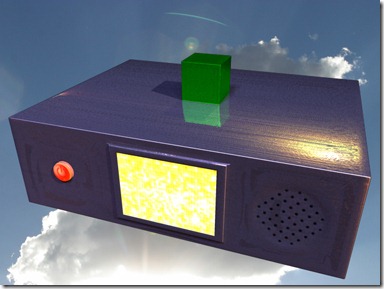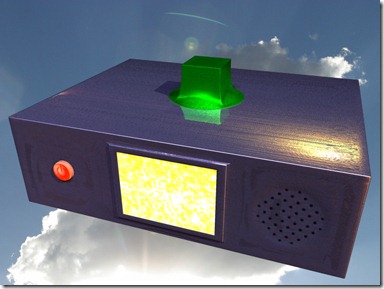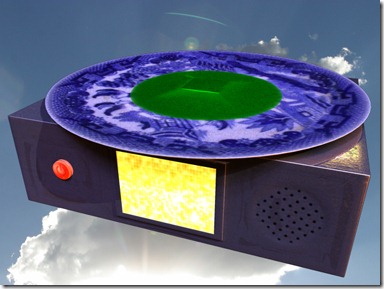Holographic Quantum Dot Technology
Products based on holographic quantum dot technology were developed by Dr. Gina Verucchio between 2394 and 2415 CE at Claudius Electronics, an electronics product and component manufacturer and retailer based in Roma, capitol of Italy prefecture on the planet Panjandrum.
Before discussing holographic quantum dot technology, we need to look at its forerunner, Claudius Electronics' quantum dot technology.
Quantum dots are a development of PNP transistor technology--semiconductor devices used to control the flow of the negative charge of electrons. They are constructed of three layers. Two layers (the "P" layers) have spaces where an electron is missing and so behave like positively charged particles. The third layer (the "N" layer), sandwiched between them, has excess electrons. If the "N" layer is thin enough, electrons show their wave-like quantum nature, and are trapped in that layer. These devices can be constructed to trap the electrons in three dimensions--"quantum dots." Quantum dots created electrostatically can be easily modified, adding or subtracting electrons, so they behave something like atoms. A quantum dot with six electrons resembles a carbon atom. Initially these "atoms" were relatively two-dimensional, or "flat," atoms, even though the electrons were trapped in this three-dimensional space. Interesting. Useful. But not quite like the real thing.
Once gaseous semiconductors and subspace circuits were developed, "three-dimensional" atoms were created. Initially, the semiconductor could be converted into what seemed to be atoms of any single element. Then, as research progressed, atoms of as many different elements as wanted could be formed. Once atoms of different elements were created, they could be combined into molecules. The electronics engineer could start with a gaseous semiconductor and, with proper programming to arrange these atoms and molecules in space, end up with a diamond--or a diamond ring. Engineers could program anything they wanted to manufacture. Of course, the product had to include its own electronics and power source.
In theory, practically anything could be programmed. But not all things were practical. For example, suppose you wanted a double jumbo cheeseburger. With the proper programming, the sandwich could be created. Unfortunately, the atoms and molecules would exist only as long as they remained part of your burger. So, if you tried it for lunch, each mouthful of your sandwich would shut down and revert to the original semiconductor. Not very appetizing.
But many other, useful, products can be programmed. Once a program is created by scanning a prototype, toys and household items can be produced cheaply. Quantum dot clothing or jewelry are very wearable.
You might ask, "Wouldn't it be very disappointing to the owner of a pawn shop or antique store to have an antique diamond ring that they acquired turn out to be a fake?"
The answer is, "Yes." But any common scanner would show that, on items created in this manner, beauty was only skin deep. Businesses like pawn shops already do scans to determine authenticity, so they shouldn't get scammed. In many cases, the quantum dot origin of the object would be obvious since it would be lighter than appearances would suggest. The quantum dot atoms and molecules are just electrons, not real atoms, so the semiconductor mass is not changed, just its appearance. Of course, something like a quantum dot diamond ring is small enough that a difference in weight might not be noticeable. An "antique" thirty-aught-six Springfield would be a different story.
Holographic Quantum Dot technology, or HQD technology as it's become known, was developed after Dr. Verucchio went to work for Claudius Electronics in 2394.
The term "holographic" in the name is a misnomer, but is used because the technology does have something in common with holography.
The image of an object can be recreated by a hologram. If you cut up the hologram, each piece still contains the information needed to reconstruct the original image, although in lower resolution. After quantum entangled miniquarks were discovered, physicists began to suspect that "holographic" quantum dots could "know," communicate with, and store information about all the others in an object via subspace. Theory suggested that if an object based on HQD technology were broken, its pieces would not revert immediately to semiconductor. The pieces of a broken ceramic dinner plate would look just like pieces of a broken ceramic dinner plate.
Going back to the double jumbo cheeseburger, you could enjoy eating the quantum dot portion (but you would probably break a tooth on the electronics and power source.) As long as the electronics and power source were operating, you could metabolize those "atoms" and "molecules." If the power were disrupted, those quantum dots would revert to semiconductor. This might not be the best outcome for you. However, HQD technology has many uses other than feeding hungry writers.
If an HQD "ceramic" dinner plate gets dropped and broken, the pieces can be placed on an HQD Programmer and rebooted. In a minute, the ceramic pieces will take on a metallic-green appearance. They melt together, morph into the shape of the plate, and the blue willow ware pattern reappears.
The term "smart appliances" has been around for ages. "Smart dinnerware," "smart jewelry," and "smart clothing" became some of the first consumer products to apply HQD technology. You go to the store, buy a plain-vanilla set of HQD dinnerware or a shirt, and the store programs it with the pattern that you picked from a catalog. If you change your mind, you can simply have it reprogrammed to whatever pattern and style you want. If you break a plate or tear a shirt, you just bring the pieces back to the store and they reboot it. No need to find a replacement. HQD jewelry was a big hit. You don't like amber any more, have your necklace reprogrammed to turquoise. HQD clothing, especially shoes, became a big seller. When your kids wore out their shoes, you just had them rebooted (no pun intended.) If they outgrow something, increase the amount of semiconductor and have it reprogrammed to a larger size and in the latest style.
Holographic Quantum Dot technology may sound like a real economy-killer--once you had a pair of HQD shoes or pants you'd have no need to ever buy another. The stock market panicked when these products first came out but the novelty quickly wore off. People soon realized that those shoes, pants, dresses, or what-have-you had to be recharged frequently. Ever have one of those dreams where you're in a fancy restaurant and you suddenly realize that you have nothing on? It wouldn't be a dream if your battery died on you. People didn't stop buying HQD products, they just became more selective. For example, some people would rather have a pair of conventional cowboy boots, swim fins, snow skis, or whatever rarely-used footwear cluttering up their closet. Others preferred a single pair of "shoes" that could have all those special occasion functions. This year you're scuba diving on a tropical reef in St. Thomas, next year you're going to Ruidoso to ski, the next you're going to follow the Spaghetti Western Rodeo circuit. Claudius Electronics didn't corner the market, or kill it, but they did very well.
The release of the portable HQD Programmer doubled the value of Claudius' stock. People were eager to download licensed patterns. The consumer could also create and store their own programs. After that advance, it didn't take much work to place the HQD Programmer into the product and make it responsive to both voice and subspace communications.
That was a feature that the fashion-conscious appreciated. Before going out someplace special, a lady just told her HQD dress what neckline, hemline, and color she wanted and, voila, she was ready to turn heads. The same for guys.
Several lines of research converged that resulted in some amazing new products. First, Gina Verucchio discovered that the electronics and quantum properties could be tweaked so that not only atoms and molecules could be created, but virtual particles could be captured--to put nuclei in the atoms. This might seem like a bit of overkill, but it led to the next development.
With the ability to give atoms nuclei, HQD atoms and molecules would have mass. A toaster with a mass, based on its semiconductor, electronics, and power source, of less than a pound would seem unnaturally light. With atoms and molecules given their "real" mass, it would weigh six pounds, like a traditional toaster. This made many HQD products seem more realistic and, thus, desirable. But that was quickly outdated as the result of a couple more developments.
First, the size of the quantum dots was decreased so more can be created from the same amount of semiconductor. Second, the actual number is programmable. The older technology just provided variations on a theme (dinnerware with different patterns or dresses in different colors and styles). The new technology allows completely different products--dinnerware can be reprogrammed to become a punch bowl, or, even more drastic, clothing. A toaster can become an extra chair for an unexpected guest. If not needed, that chair can become an extra plate.
 This means that the consumer no longer goes shopping for dinnerware or clothes or a chair. She goes to Claudius Electronics and buys a metallic-green Default Cube of the appropriate size, takes it home, and programs it to the product desired. Again, this might seem to be the end to traditional products, but it wasn't.
This means that the consumer no longer goes shopping for dinnerware or clothes or a chair. She goes to Claudius Electronics and buys a metallic-green Default Cube of the appropriate size, takes it home, and programs it to the product desired. Again, this might seem to be the end to traditional products, but it wasn't.
Even after the third development, subspace power delivery, which eliminated periodic recharging of the batteries, not everyone wanted all their belongings to be HQD
 devices. A real set of dinnerware has certain advantages over something that must be constantly powered.
devices. A real set of dinnerware has certain advantages over something that must be constantly powered.
One of the last advances in HQD technology was the ability to produce products that were indistinguishable from the real thing (except to special scanners.) Holographic quantum dot devices were programmed to not only know about the other atoms and molecules in an object, but what and where others should be in the object. An HQD statue would have the heft of solid bronze and ordinary scanning would show that it
 was solid bronze. As far as the scanner is concerned, the electronics and power supply would be invisible, replaced by images of atoms or molecules.
was solid bronze. As far as the scanner is concerned, the electronics and power supply would be invisible, replaced by images of atoms or molecules.
These new HQD products provided a method of rapid prototyping for testing before the real object was put into production. Or an HQD product could be used in place of a difficult-to-obtain object. For instance, suppose a bridge was in danger of collapsing because of a faulty girder. The faulty girder could be replaced with an HQD girder and function for days or weeks until the real replacement arrived. You wouldn't want to build the bridge from HQD girders in the first place because of the need to continually provide power to all those girders. Once manufactured, a real girder requires no power source.
"Hacking Matter," by Wil McCarthy (Basic Books, © 2003) has a good introduction to the phenomenon of quantum dots.
Page updated: 13 June 2019
Page created: 26 October 2012